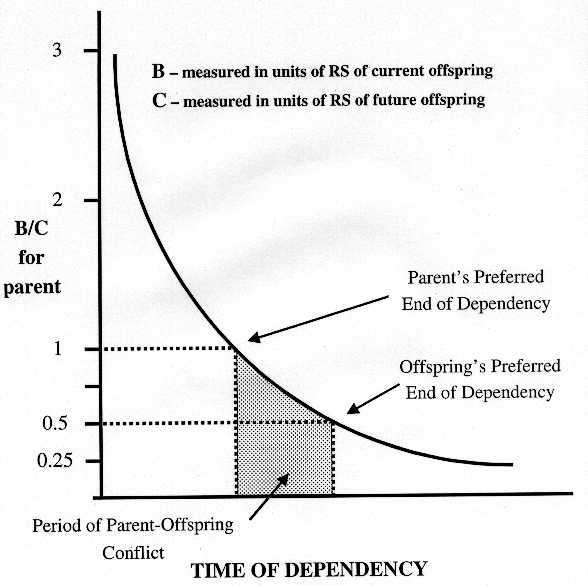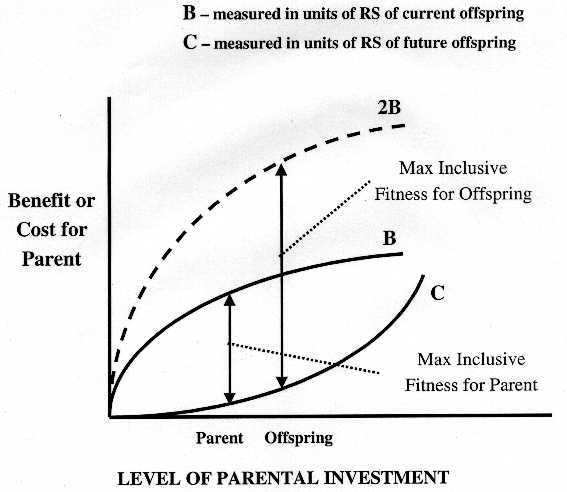
Parental Care
I. Definition
Parental Care -- Any form of parental behavior that appears likely to increase the
fitness of a parent's offspring
Parental Investment -- Any form of parental behavior that increases an individual offspring's fitness at the cost of the parent's ability to invest in future offspring
II. Types
A. Care before birth of offspring -- Ex. preparation of nests, burrows, or territories
B. Investment in gamete production -- Ex. female katydids who consume spermatophores provided by males have larger eggs which survive overwintering better
C. Care of eggs -- Ex. incubation by birds, egg guarding by fish, carrying brood by waterbugs and seahorses
D. Provisioning or protecting young -- Ex. provisioning by birds, brooding fry in mouth in some fish, lactation in mammals
E. Care following nutritional independence -- Ex. support in conflicts in social primates
II. How common is parental care and who provides it?
A. Terrestrial Arthropods
1. PC is uncommon - found in only 85 orders
2. Care by females much more common than care by males
B. Reptiles - care by females more common
C. Amphibians - care-giving by males and females fairly similar
C. Bony Fish - male care more common than female care
D. Birds - 90% of over 9000 species show biparental care
E. Mammals - 100% of species show care by females (gestation, lactation) but less than 5% show direct male care
F. Why is care by females more common than care by males?
1. The paternity uncertainty hypothesis
2. The order of gamete release hypothesis
3. The association hypothesis
All predict a relationship between form of fertilization (external versus internal) and which sex provides care
II. How much care is given and when is care terminated?
A. Recall Trivers' defintion of parental investment: investment in current offspring must be costly in terms of parent's ability to invest in future offspring. These can be either opportunity costs or direct costs
Ex. Direct costs -- in some cichlids, both male and female interspawn interval are greater for individuals showing parental care which => lower reproductive output

B. Parent-offspring conflict over termination of care[1] Costs to parent and benefits to offspring change over the period of offspring dependency such that the B/C ratio shows continual decrease
[2] From a parent's point of view -- want to terminate parental investment in offspring as soon as it becomes more advantageous to invest in future offspring (i.e. when B/C ratio drops to 1.0)
[3] From offspring's point of view -- want parental investment to continue until costs exceed 2X benefits (i.e. when B/C ratio drops to 0.5)
[4] This is because parents are related to both current and future offspring by same degree of relatedness (0.5) but offspring are related by twice as much to themselves as to future siblings (1.0 vs. 0.5)
[5] This generates a conflict of interest between parents and offspring over when parent investment should be terminated
[6] When future offspring are expected to be half siblings rather than full siblings, period of conflict should extend longer

C. Parent-offspring conflict over level of care
[1] There should also be a conflict over the amount of investment given at any moment during the period of dependency because whatever benefits that result from investment will be twice as great for offspring as for parents because of their differences in how closely they are related to offspring (1.0 to self to self versus 0.5 parent to offspring) while whatever costs will be equivalent because of same degree of relatedness to future offspring / siblings (assuming that future siblings are full siblings)

C. Other predictions based on theory:
[1] Level of investment should be greater and period of investment should be longer as parental age increases because of declining residual reproductive value of the parent (basically, their likelihood of having and successfully raising future offspring)
[2] Offspring should be selected to be manipulators of parents and parents to detect and resist manipulation by offspring
D. Prevalence of weaning conflict and tantrums in many birds and mammals is consistent with theory
References
Bull, J. J. 1985 Models of parent-offspring conflict: effect of environmental variance.
Heredity 55: 1-8.
Clutton-Brock, T.H. 1991 The Evolution of Parental Care. Princeton University Press,
Princeton, New Jersey.
Coleman, R. M., M. R. Gross & R. C. Sargent 1985 Parental investment decision
rules: a test in bluegill sunfish. Behav. Ecol. Sociobiol. 18: 59-66.
Emlen, S.T. and P.H. Wrege 1992 Parent-offspring conflict and the recruitment of
helpers among bee-eaters. Nature 356:331-333.
Godfray, H.C.J. 1995 Evolutionary theory of parent-offspring conflict. Nature
376:133-138.
Gross, M. R. & R. Shine 1981 Parental care and mode of fertilization in ectothermic
vertebrates. Evol. 35: 775-593.
Lavery, R.J. & P.W. Colgan 1991 Brood age and parental defence in the convict
cichlid, Cichlasoma nigrofasciatum (Pisces: Cichlidae). Anim. Behav. 41:945-951.
Maynard Smith, J. 1977 Parental investment: a prospective analysis. Anim. Behav.
25:1-9.
Mock, D.W. and G.A. Parker 1998 Siblicide, family conflict, and the evolutionary
limits of selfishness. Animal Behaviour 56:1-10.
Pagel, M. 1997 Desperately concealing father: a theory of parent-infant resemblance.
Anim. Behav. 53:973-981.
Parker, G. A. & M. R. MacNair 1978 Models of parent-offspring conflict. I. Monogamy.
Anim. Behav. 26: 97-110.
Parker, G. A. & M. R. MacNair 1979 Models of parent-offspring conflict. IV. Evolutionary
retaliation by the parent. Anim. Behav. 27: 1210-1235.
Trivers, R. L. 1972 Parental investment and sexual selection. In: Sexual Selection
and the Descent of Man. B. Campbell, ed. Aldine, Chicago, pp. 136-179.
Trivers, R. L. 1974 Parent-offspring conflict. Amer. Zool. 14: 249-264.
Trivers, R.L. 1985 Social Evolution. Benjamin Cummings Press, Menlo Park.
Winkler, D. W. and G. S. Wilkinson 1988 Parental effort in birds and mammals: theory
and measurement. Oxford Surveys in Evolutionary Biology 5:185-214.